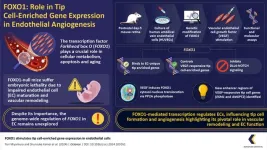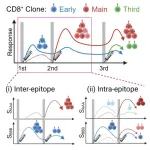(Press-News.org) Research Highlights:
A study of more than 1,400 people in U.S. tribal communities found that high cholesterol was twice as prevalent among American Indian adolescents and young adults compared to the overall U.S. population.
The study also noted that few study participants with high cholesterol sought or received treatment during the study period.
DALLAS, March 8, 2024 — Young American Indians, ages 15-39, had cholesterol levels more than two times higher than the general U.S. population, according to new research published in the Journal of the American Heart Association, an open access, peer-reviewed journal of the American Heart Association.
The researchers noted that previous research has estimated that approximately 25% of adolescents and approximately 30% of young adults in the U.S. have high cholesterol.
“This is the first study of total cholesterol levels in American Indian adolescents and young adults, and we were surprised by the levels of high cholesterol, especially in adolescents,” said principal investigator Ying Zhang, M.D., Ph.D., an associate professor of biostatistics and director of the Center for American Indian Health Research at the University of Oklahoma Health Sciences Center in Oklahoma City. “The high cholesterol in this population will likely lead to subtle damage in blood vessels and to premature heart disease. There is a need for care including early screening and treatment for high cholesterol levels.”
Researchers reviewed data from the Strong Heart Family Study — a study of risk factors for cardiovascular diseases among tribal communities in central Arizona, southwest Oklahoma, North Dakota and South Dakota. High cholesterol and its role in the development of heart disease and stroke was assessed among 1,440 American Indian teens and adults in the study.
The analysis found:
The prevalence of high cholesterol was 55.2% for American Indian adolescents, ages 15-19; 73.6% for American Indian young adults, ages 20-29; and 78% for American Indian adults, ages 30-39 years old.
Roughly 2.8% of all study participants had LDL-C, also known as “bad cholesterol,” higher than 160 mg/dL, which is above the recommended threshold for adults ages 20-39 years old.
During the follow-up examination in 2006-2009, 9.9% of participants had arterial plaque, 11% had plaque progression, and 9% had cardiovascular disease events. Arterial plaque are fatty deposits that accumulate on the inside of arteries, narrowing the vessels, which increase the risk of a number of health conditions, including peripheral artery disease, coronary heart disease and chronic kidney disease.
Participants with total cholesterol higher than 200 mg/dL had more than twice the risk of arterial plaque compared to participants with cholesterol lower than 200 mg/DL, as well as greater plaque buildup.
Despite the high prevalence of an imbalance of blood lipid levels (dyslipidemia) and the recommended cholesterol thresholds for intervention, none of the participants who were younger than age 20 were taking lipid-lowering medication during the study’s initial examination or 6-8 years later at the follow-up examination. (Dyslipidemia is an imbalance of blood lipid levels that can include high levels of low-density lipoproteins (“bad” cholesterol) or triglycerides (the most common type of fat in the body) or low levels of high-density lipoproteins (“good” cholesterol).)
1.8% of the participants were taking lipid-lowering medications during the baseline exam, from 2001-2003. The use of lipid-lowering medication remained low at the follow-up examination, from 2006-2009, with 8% of participants taking medication to help lower cholesterol.
“It is our hope that our study’s results attract attention within the health care community,” Zhang said. “It would be beneficial for American Indian youth and young adults to get recommendations from their physicians about regularly checking cholesterol levels and following the AHA’s Life’s Essential 8 to help improve their cardiovascular health and prevent heart disease and stroke.”
Study details, background or design:
The Strong Heart Study is focused on genetic and conventional cardiovascular risk factors among American Indians.
The study was conducted between 2001-2003 through 2020 and included American Indian teens and adults ages 15-39 at the time of enrollment. Roughly 57% of the study’s participants self-identified as female, and 43% of participants self-identified as male.
Cardiovascular events were identified through 2020, with a median follow-up of 18.5 years.
Cholesterol levels were measured once, after a 12-hour fast at a follow-up exam.
Ultrasounds of the carotid artery were used to detect arterial plaque at enrollment and follow-up, with median follow-up of 5.5 years.
Study limitations include that the results may only be generalizable to other populations with a high prevalence of cardiometabolic risk factors, such as Type 2 diabetes, prediabetes, high cholesterol and abdominal obesity, similar to American Indian populations.
According to the Association’s 2020 scientific statement, Cardiovascular Health in American Indians and Alaska Natives, heart disease rates are noted as approximately 50% higher among the 5.2 million Americans who self-identify as American Indian and/or Alaska Native, compared to white Americans. In addition, Type 2 diabetes affects American Indian and Alaska Native adults at three times the rate of white adults in the U.S., and American Indian and Alaska Native adults develop cardiovascular diseases at younger ages in comparison to white adults.
Co-authors, disclosures and funding sources are listed in the manuscript. The Strong Heart Study has been funded by the National Heart, Lung, and Blood Institute, a division of the National Institutes of Health, for more than three decades.
Studies published in the American Heart Association’s scientific journals are peer-reviewed. The statements and conclusions in each manuscript are solely those of the study authors and do not necessarily reflect the Association’s policy or position. The Association makes no representation or guarantee as to their accuracy or reliability. The Association receives funding primarily from individuals; foundations and corporations (including pharmaceutical, device manufacturers and other companies) also make donations and fund specific Association programs and events. The Association has strict policies to prevent these relationships from influencing the science content. Revenues from pharmaceutical and biotech companies, device manufacturers and health insurance providers and the Association’s overall financial information are available here.
Additional Resources:
Multimedia is available on the right column of release link.
View the manuscript online.
AHA news release: American Indian and Alaska Native adults had higher rate of premature heart attack deaths (November 2023)
AHA news release: New medication given every 1-3 months may slash stubborn high cholesterol | American Heart Association (November 2023)
AHA health information: What is Cholesterol?
AHA health information: What Your Cholesterol Levels Mean
AHA health initiative: Health Care by Food™
Follow AHA/ASA news on X (formerly known as Twitter) @HeartNews
Follow news from the Journal of the American Heart Association @JAHA_AHA
About the American Heart Association
The American Heart Association is a relentless force for a world of longer, healthier lives. We are dedicated to ensuring equitable health in all communities. Through collaboration with numerous organizations, and powered by millions of volunteers, we fund innovative research, advocate for the public’s health and share lifesaving resources. The Dallas-based organization has been a leading source of health information for a century. During 2024 - our Centennial year - we celebrate our rich 100-year history and accomplishments. As we forge ahead into our second century of bold discovery and impact, our vision is to advance health and hope for everyone, everywhere. Connect with us on heart.org, Facebook, X or by calling 1-800-AHA-USA1.
###
END
High cholesterol was twice as prevalent among American Indian teens and young adults
More than half of American Indian teens and nearly two-thirds of American Indian young adults had high levels of cholesterol compared to the general population, finds new study in Journal of the American Heart Association
2024-03-08
ELSE PRESS RELEASES FROM THIS DATE:
Good news for coral reef restoration efforts: Study finds “full recovery” of reef growth within four years
2024-03-08
While the majority of the world’s reefs are now under threat or even damaged potentially beyond repair, a new study reported in the journal Current Biology on March 8 offers some encouraging news: efforts to restore coral reefs not only increase coral cover, but they can also bring back important ecosystem functions, and surprisingly fast.
“We found that restored coral reefs can grow at the same speed as healthy coral reefs just four years after coral transplantation,” says Ines Lange (@InesLange9) of University of Exeter, UK. “This means that they provide lots of habitat for ...
Balancing training data and human knowledge makes AI act more like a scientist
2024-03-08
When you teach a child how to solve puzzles, you can either let them figure it out through trial and error, or you can guide them with some basic rules and tips. Similarly, incorporating rules and tips into AI training—such as the laws of physics—could make them more efficient and more reflective of the real world. However, helping the AI assess the value of different rules can be a tricky task.
Researchers report March 8 in the journal Nexus that they have developed a framework for assessing the ...
Restored coral reefs can grow as fast as healthy reefs
2024-03-08
Planting new coral in degraded reefs can lead to rapid recovery – with restored reefs growing as fast as healthy reefs after just four years, new research shows.
Reefs worldwide are severely threatened by local and global pressures. In Indonesia, where the study was carried out, destructive blast fishing destroyed large reef areas 30-40 years ago – with no signs of recovery until now.
The Mars Coral Reef Restoration Programme attempts to restore degraded reefs by transplanting coral fragments onto a network of interconnected ...
Continuous Medicaid eligibility during the pandemic and postpartum coverage, health care, and outcomes
2024-03-08
About The Study: In this study including 47,000 participants, continuous Medicaid eligibility during the COVID-19 pandemic significantly reduced loss of Medicaid after birth, suggesting similar uninsurance reductions may be expected from post-pandemic postpartum Medicaid extensions, which most states plan to implement.
Authors: Jamie R. Daw, Ph.D., of the Columbia University Mailman School of Public Health in New York, is the corresponding author.
To access the embargoed study: Visit our For The Media website at this link https://media.jamanetwork.com/
(doi:10.1001/jamahealthforum.2024.0004)
Editor’s ...
Perspectives of Black patients on racism within emergency care
2024-03-08
About The Study: This qualitative study including 25 interviews with Black patients discharged from the emergency department described these patients’ perspectives about racism in health care, recent clinical experiences, and thoughts on system improvements. Black patients described a notable amount of medical mistrust, anticipation of racism in emergency care, and personal experiences with clinical instances of racism in emergency treatment.
Authors: Anish K. Agarwal, M.D., M.P.H., M.S., of the University of Pennsylvania in Philadelphia, is the corresponding ...
Impact of onset time, number, type, and sequence of extrahepatic organ failure on prognosis of acute-on-chronic liver failure
2024-03-08
Background and Aims
The impact of the characteristics of extrahepatic organ failure (EHOF) including the onset time, number, type, and sequence on the prognosis of acute-on-chronic liver failure (ACLF) patients remains unknown. This study aimed to identify the association between the characteristics of EHOF and the prognosis of ACLF patients.
Methods
ACLF subjects enrolled at six hospitals in China were included in the analysis. The risk of mortality based on the characteristics of EHOF was evaluated. Survival of study groups was ...
High-tech 'paint' could spare patients repeated surgeries
2024-03-08
UVA Health researchers have received $2.8 million to advance their development of a high-tech way to save heart and dialysis patients from the need for multiple surgeries.
Researchers Lian-Wang Guo, PhD, and K. Craig Kent, MD, are pioneering a quick and gentle technique to “paint” tiny nanoparticles on transplanted veins to prevent the veins from becoming clogged in the future. This type of blockage often causes cardiovascular and dialysis patients to require repeated surgeries; approximately half of all heart ...
Unveiling the role of FOXO1 in vascular development and transcriptional dynamics in endothelial cells
2024-03-08
The human vascular system, a complex network of blood vessels, plays an essential role in maintaining health. Understanding the molecular mechanisms underlying vascular development is important for tackling age-related disorders. The Forkhead box O (FOXO1) transcription factor is crucial in processes related to aging, cellular metabolism, and apoptosis. Despite its significance, the comprehensive regulation of FOXO1 across the genome in endothelial cells (EC) has not been investigated.
In a new paper published in iScience in February 2024, a research team from Kumamoto University ...
Call for papers| Special Issue on advanced robotics and tissue engineering
2024-03-08
Scope
For decades, robotic systems have played a pivotal role in nurturing the growth of tissue-engineered constructs in controlled environments through the provision of mechanical stimulation. The importance of physical stresses in tissue maturation is not only intuitive from our own bodily experiences but is also supported by a growing body of mechanotransduction research. However, experimental studies have predominantly remained confined to basic in vitro setups, hampering our ability to produce functional grafts that can translate into clinical practice. Emerging evidence suggests that replicating physiological stresses more faithfully could further enhance the functionality of tissue ...
Optimizing boosters: How COVID mRNA vaccines reshape immune memory after each dose
2024-03-08
mRNA vaccines developed against the spike glycoprotein of severe acute respiratory syndrome type 2 coronavirus (SARS-CoV-2), displayed remarkable efficiency in combating coronavirus 19 (COVID-19). These vaccines work by triggering both cellular and humoral immune responses against the spike protein of the virus. Cellular immunity may play a more protective role than humoral immunity to variants of concerns (VOC) against SARS-CoV-2, as it targets the conserved regions of spike protein and possibly cross-reacts with other variants.
Since a single spike epitope is recognized by multiple T-cell clones, the ...
LAST 30 PRESS RELEASES:
Strategic river sensors could have forewarned of Texas Camp flood disaster
Drone sampling of whale breath reveals first evidence of potentially deadly virus in Arctic
Roman soldiers defending Hadrian’s Wall infected by parasites, study finds
Pinochet’s prisoners were tormented with music but still found solace in it, a new book reveals
Fertility remains high in rural Tanzania despite access to family planning
AI-assisted device can improve autism care access
Kinetic careers
Uncovering how parasitic plants avoid attacking themselves to improve crop resistance
Nanoparticle vaccine strategy could protect against Ebola and other deadly filoviruses
Study finds brain care score can predict risk of stroke across racial groups
Key lung immune cells can intensify allergic reactions
Do hormones explain why women experience more gut pain?
New materials conduct ions in solids as easily as in liquids
Breakthrough of the Year: Renewable energy begins to eclipse fossil fuel-based sources
LLM use is reshaping scientific enterprise by increasing output, reducing quality and more
Introducing LightGen, a chip for ultra-fast, ultra-efficient generative AI
Astronomers see fireworks from violent collisions around nearby star
ACC/AHA issue new guideline on managing congenital heart disease in adults
Cosmic crash caught on camera
Is talented youth nurtured the wrong way? New study shows: top performers develop differently than assumed
Ants: An untapped resource in the development of antibiotics?
Archaeologists use AI to create prehistoric video game
Mitochondria migrate toward the cell membrane in response to high glucose levels
Tiny viral switch offers hope against drug-resistant bacteria
Most parents aware of early peanut introduction guidelines, but confused about details
HPV vaccine can protect against severe lesions of the vulva and vagina
Virtual care provision and emergency department use among children and youth
Quadrivalent HPV vaccine and high-grade vulvovaginal lesions
Insights into dry eyes gained from stem cell-derived tear glands
Researchers identify 166 human pluripotent stem cell lines available for use in clinical applications
[Press-News.org] High cholesterol was twice as prevalent among American Indian teens and young adultsMore than half of American Indian teens and nearly two-thirds of American Indian young adults had high levels of cholesterol compared to the general population, finds new study in Journal of the American Heart Association





